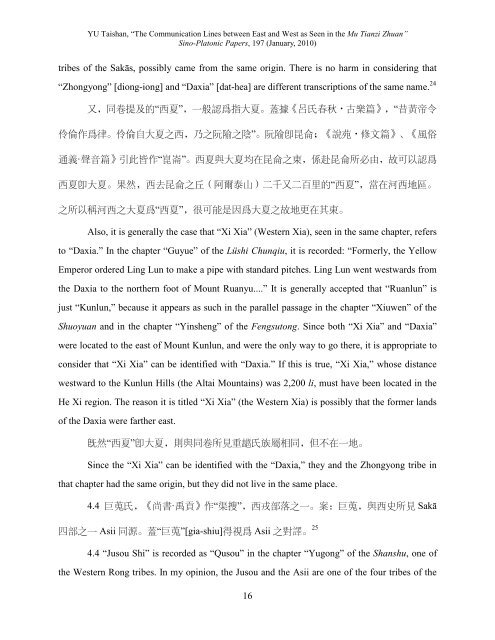Mu Tianzi Zhuan - Sino-Platonic Papers
Mu Tianzi Zhuan - Sino-Platonic Papers
Mu Tianzi Zhuan - Sino-Platonic Papers
You also want an ePaper? Increase the reach of your titles
YUMPU automatically turns print PDFs into web optimized ePapers that Google loves.
YU Taishan, “The Communication Lines between East and West as Seen in the <strong>Mu</strong> <strong>Tianzi</strong> <strong>Zhuan</strong>”<br />
<strong>Sino</strong>-<strong>Platonic</strong> <strong>Papers</strong>, 197 (January, 2010)<br />
tribes of the Sakās, possibly came from the same origin. There is no harm in considering that<br />
“Zhongyong” [diong-iong] and “Daxia” [dat-hea] are different transcriptions of the same name. 24<br />
又,同卷提及的“西夏”,一般認爲指大夏。蓋據《呂氏春秋·古樂篇》,“昔黃帝令<br />
伶倫作爲律。伶倫自大夏之西,乃之阮隃之陰”。阮隃卽昆侖;《說苑·修文篇》、《風俗<br />
通義·聲音篇》引此皆作“崑崙”。西夏與大夏均在昆侖之東,係赴昆侖所必由,故可以認爲<br />
西夏卽大夏。果然,西去昆侖之丘(阿爾泰山)二千又二百里的“西夏”,當在河西地區。<br />
之所以稱河西之大夏爲“西夏”,很可能是因爲大夏之故地更在其東。<br />
Also, it is generally the case that “Xi Xia” (Western Xia), seen in the same chapter, refers<br />
to “Daxia.” In the chapter “Guyue” of the Lüshi Chunqiu, it is recorded: “Formerly, the Yellow<br />
Emperor ordered Ling Lun to make a pipe with standard pitches. Ling Lun went westwards from<br />
the Daxia to the northern foot of Mount Ruanyu....” It is generally accepted that “Ruanlun” is<br />
just “Kunlun,” because it appears as such in the parallel passage in the chapter “Xiuwen” of the<br />
Shuoyuan and in the chapter “Yinsheng” of the Fengsutong. Since both “Xi Xia” and “Daxia”<br />
were located to the east of Mount Kunlun, and were the only way to go there, it is appropriate to<br />
consider that “Xi Xia” can be identified with “Daxia.” If this is true, “Xi Xia,” whose distance<br />
westward to the Kunlun Hills (the Altai Mountains) was 2,200 li, must have been located in the<br />
He Xi region. The reason it is titled “Xi Xia” (the Western Xia) is possibly that the former lands<br />
of the Daxia were farther east.<br />
旣然“西夏”卽大夏,則與同卷所見重豅氏族屬相同,但不在一地。<br />
Since the “Xi Xia” can be identified with the “Daxia,” they and the Zhongyong tribe in<br />
that chapter had the same origin, but they did not live in the same place.<br />
4.4 巨蒐氏,《尚書·禹貢》作“渠搜”,西戎部落之一。案:巨蒐,與西史所見 Sakā<br />
四部之一 Asii 同源。蓋“巨蒐”[gia-shiu]得視爲 Asii 之對譯。 25<br />
4.4 “Jusou Shi” is recorded as “Qusou” in the chapter “Yugong” of the Shanshu, one of<br />
the Western Rong tribes. In my opinion, the Jusou and the Asii are one of the four tribes of the<br />
16
















